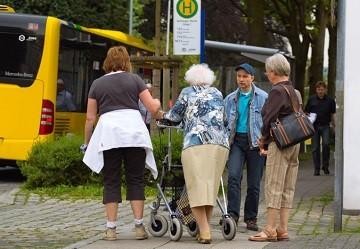
Expanding Transportation Options for an Aging Population
 AARP survey data show that most older people want to age in place, remaining in their homes and communities for as long as possible. To do this successfully, seniors need to be able to access the supports, services, and amenities that they will require as they age, such as making trips to the grocery store, the doctor’s office, or a friend’s home. Such trips typically are taken by car; however, because people live an average of 7 to 10 years beyond their ability to drive safely, these seniors will need alternative transportation choices to maintain their independence. Too often, however, the existing built environment and transportation infrastructure in the nation’s communities lack safe, viable options such as public transit, biking, or walking.
AARP survey data show that most older people want to age in place, remaining in their homes and communities for as long as possible. To do this successfully, seniors need to be able to access the supports, services, and amenities that they will require as they age, such as making trips to the grocery store, the doctor’s office, or a friend’s home. Such trips typically are taken by car; however, because people live an average of 7 to 10 years beyond their ability to drive safely, these seniors will need alternative transportation choices to maintain their independence. Too often, however, the existing built environment and transportation infrastructure in the nation’s communities lack safe, viable options such as public transit, biking, or walking.
“We are running to catch up,” Kathryn Lawler, director of the Atlanta Regional Commission’s Area Agency on Aging, says of efforts to meet the transportation needs of a growing older population. “For 60 years, we’ve built for the car,” she explains. “[Now] we have to imagine a different way of living.”
How we might achieve that new way of living — one that offers seniors multiple options to get around — was the topic of a panel discussion, “Boomers in the ’Burbs: Aging in Place,” hosted by the National Building Museum on October 29, 2013. Joining Lawler were Kelly Morphy, executive director of the Walkable and Livable Communities Institute, and June Williamson, professor at the Bernard and Anne Spitzer School of Architecture at the City College of New York. The panel shared insights on current barriers to seniors’ transportation independence, discussed strategies and practices to overcome those challenges, and highlighted the many benefits of expanded transportation options.
Challenges
One of the biggest challenges to ensuring that seniors can get around even as they lose their ability to drive is that most communities have been built solely for cars; they simply are not designed to accommodate multiple modes of transportation. Walking or biking on streets designed for cars can be a scary prospect for people of all ages but especially for seniors, who may have physical limitations. In addition, notes Morphy, as many as 15.5 million seniors will live in areas with poor transit options by 2015. The low-density, use-specific, auto-dependent environment of rural and suburban areas, where most seniors live, lacks the connectivity and walkability to offer seniors real alternatives to auto transportation.
Significant obstacles, however, are blocking the changes required to create the type of walkable, livable communities imagined by Morphy and other advocates. Local land-use ordinances and other regulations may actually make desirable changes illegal, Lawler points out. She notes that local officials, who tend to be rewarded for what they can deliver in the short term, may be reluctant to support the long-term investment required to make significant changes to infrastructure and the built environment. In addition, community residents themselves may be averse to change. Despite evidence that people increasingly value walkability in their communities, for example, Morphy encounters frequent opposition from homeowners who do not want sidewalks running through their front yards.
Strategies
Making streets safe and comfortable for users of various modes of transportation requires thoughtful planning and design. Planners can incorporate a range of traffic-calming design features to improve street access for walkers and bikers. Narrower auto lanes create space for sidewalks and bike lanes. Replacing intersections with traffic circles, adding buffers such as landscaping between streets and sidewalks, enhancing the visibility of crosswalks, and adding z-shaped or staggered crosswalks that force pedestrians to face traffic as they walk through an island between lanes all promote safe walkability. Such interventions are not anti-car but rather are oriented toward shared use. “Options, options, options,” says Lawler; the goal is to ensure viable transportation choices, cars included.
Expanding transportation choices does not end with changing the design of our streets. Entire communities can be adapted in ways that make alternative modes of transportation more attractive. Despite the considerable obstacles posed by typical suburban development, argues Williamson, “there are ample opportunities to retrofit” suburbs to better suit the needs of older residents. Obsolete commercial real estate, for example, can be repurposed with walkability and connectivity in mind. A notable case of suburban retrofitting is Seattle’s Thornton Place, in which the former Northgate Mall was redeveloped to include senior housing with pedestrian access to retail, restaurants, and public transportation.
efits
In addition to contributing to transportation independence and helping seniors to age in place (worthy goals in their own right), expanding transportation options promises additional benefits for seniors and the broader community. Safe places to walk and bike increase opportunities for physical activity and its accompanying health gains, decreased dependence on cars offers environmental benefits, and improved transportation planning can boost local economies.
Morphy sees investment in multiuse transportation infrastructure as the first step in broader redevelopment. “Start with public investment and private investment will come,” she says, citing the example of West Palm Beach, Florida, where traffic calming measures helped spur downtown revitalization. Improved walkability, according to a study by CEOs for Cities, is also associated with increased property values.
Making the Case for Change
As the population of older adults grows — the population over age 65 is expected to double by 2040 — meeting seniors’ transportation needs will remain a critically important issue. The panelists discussed ways to build momentum for the movement to expand transportation options for seniors. Morphy stresses that community buy-in is essential and that residents need to be full participants in the process of change. Williamson points out that design visualization, especially before and after pictures or renderings, can be a powerful tool to gain support for new uses.
Perhaps the strongest case for making transportation-related changes that will help seniors age in place is that everyone will benefit. “In Atlanta,” says Lawler, “we’ve found there are only two kinds of people — seniors and future seniors.” Everyone has a stake in creating an aging-friendly built environment and transportation infrastructure, something that many who are now caring for older parents are learning firsthand. But beyond the fact that everyone might need aging-friendly features at some point in the future, the design elements that make communities safely walkable and increase transportation options for older people also benefit younger people today. As Morphy puts it, when we “meet the needs of seniors, we meet the needs of all.”
For more on aging in place, see the upcoming Fall 2013 issue of Evidence Matters, which provides a sense of the breadth of housing and community development issues associated with the graying of America.
PD&R Leadership Message Archive
International & Philanthropic Spotlight Archive
Spotlight on PD&R Data Archive
Publications
Collecting, Analyzing, and Publicizing Data on Housing Turnover
Resilience Planning: What Communities Can Do to Keep Hazards from Turning into Disasters
Cityscape: Volume 26, Number 3
Case Studies
Case Study: Former School in Charleston, South Carolina, Transformed into Affordable Housing for Seniors
Case Study: Avalon Villas Combines Affordable Housing and Services for Families in a Gentrifying Phoenix Neighborhood

The contents of this article are the views of the author(s) and do not necessarily reflect the views or policies of the U.S. Department of Housing and Urban Development or the U.S. Government.
Note: Guidance documents, except when based on statutory or regulatory authority or law, do not have the force and effect of law and are not meant to bind the public in any way. Guidance documents are intended only to provide clarity to the public regarding existing requirements under the law or agency policies.



